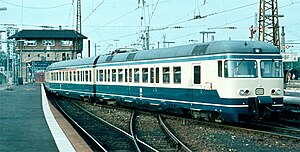DB series ET 27
| DB series ET 27 | |
|---|---|
|
427 in Stuttgart Hbf, 1974
|
|
| Numbering: | ET 27 001-005a / b, EM 27 001-005; from 1968: 427/827 |
| Number: | 5 |
| Manufacturer: | MAN / Wegmann & Co. , electrics: AEG / BBC |
| Year of construction (s): | 1964 |
| Retirement: | 1984-1986 |
| Axis formula : | Bo'Bo '+ 2'2' + Bo'Bo ' |
| Type : | Local multiple unit |
| Gauge : | 1,435 mm standard gauge |
| Length over coupling: | 73,850 mm |
| Height: | 3,870 / 4,260 mm |
| Width: | 2,864 mm |
| Bogie axle base: | 2,500 mm |
| Payload: | 134 t |
| Service mass: | 135.0 t |
| Wheel set mass : | 16.0 t |
| Top speed: | 120 km / h |
| Continuous output : | 1,200 kW |
| Acceleration: | 0.48 m / s² |
| Wheel diameter: | 900 mm |
| Power system : | 15 kV 16.67 Hz AC |
| Drive: | 4 × 4-pole single-phase series motors |
| Brake: | electrical resistance brake |
| Train heating: | electrical resistance heating |
| Coupling type: | Scharfenberg coupling |
| Seats: | 185 24 (1st class) 161 (2nd class) |
| Standing room: | 265 |
| Floor height: | 905 mm |
| Particularities: | pneumatic door locking device |
The multiple units of the series ET 27 (from 1968: series 427 ) of the Deutsche Bundesbahn were designed for local express traffic in metropolitan areas . They consisted of two railcars and a middle car without a drive. The trains carried the 1st and 2nd carriage classes and had a luggage compartment.
history
The Deutsche Bundesbahn put five units into service in 1963. In everyday life, these multiple units could not prove themselves due to the weak transformer and the low engine power, which was due to the low vehicle floor of 800 millimeters. At that time, platform heights of 38 centimeters were common on the Federal Railroad. Only a few platforms were 55 or 76 centimeters high. The operation of the doors was also immature. Far from the convenient operation of today's S-Bahn / U-Bahn doors at the push of a button, the doors of the ET 27 could only be opened by many passengers with the help of fellow travelers or the train crew.
The ET 27 series is considered to be an early prototype of the 420 S-Bahn series , which is clear from the division of the interior with three entry and exit areas and some design details such as the curved front windows. The operating experience from the existing S-Bahn networks ( Hamburg and Berlin ) led to the development of the new S-Bahn trains of the 420 series with a thyristor control and for platform heights of 76 or 95 centimeters.
The ET 27 were only used in suburban traffic in Stuttgart . B. on the routes to Böblingen and Ulm / Neu-Ulm . In the 1980s, the Plochingen - Göppingen - Geislingen section was the focus of operations. The multiple units were stationed in Esslingen and later in Tübingen .
In 1968 they were given the series designations 427 (powered end cars) and 827 (intermediate car). During the last main inspection in the Cannstatt repair shop , the paintwork was changed from purple to ocean blue-beige.
On December 31, 1984, four trains were held at the Bw (102, 104 and 105 427 101,) Tübingen. In 1985 the multiple units were completely retired. After that they were parked in the Tübingen depot for some time before three of them were scrapped.
Unit 427 105 was acquired by a railway dealer who wanted to sell it to BLS Lötschbergbahn . Due to the poor condition, including the leaky front window, the deal did not take place. The vehicle was discovered by railway enthusiasts in Switzerland . The multiple unit is currently not publicly accessible in Stuttgart, but an operational refurbishment is not expected.
literature
- Obermayer: Paperback German railcars . Kosmos, Stuttgart 1996, ISBN 3-440-04054-2
- The locomotives of the Deutsche Bundesbahn 1985 , EK-Verlag, Freiburg 1985, ISBN 3-88255-785-0
- Gottwaldt: 100 Years of German Electric Locomotives , p. 183, Franckh, Stuttgart 1979, ISBN 3-440-04696-6
Web links
Individual evidence
- ↑ a b Not beautiful, but rare , in: That was the DB 1963/1964 , GeraMond, Munich 2015, ISBN 978-3-86245-024-4 , p. 64 f


